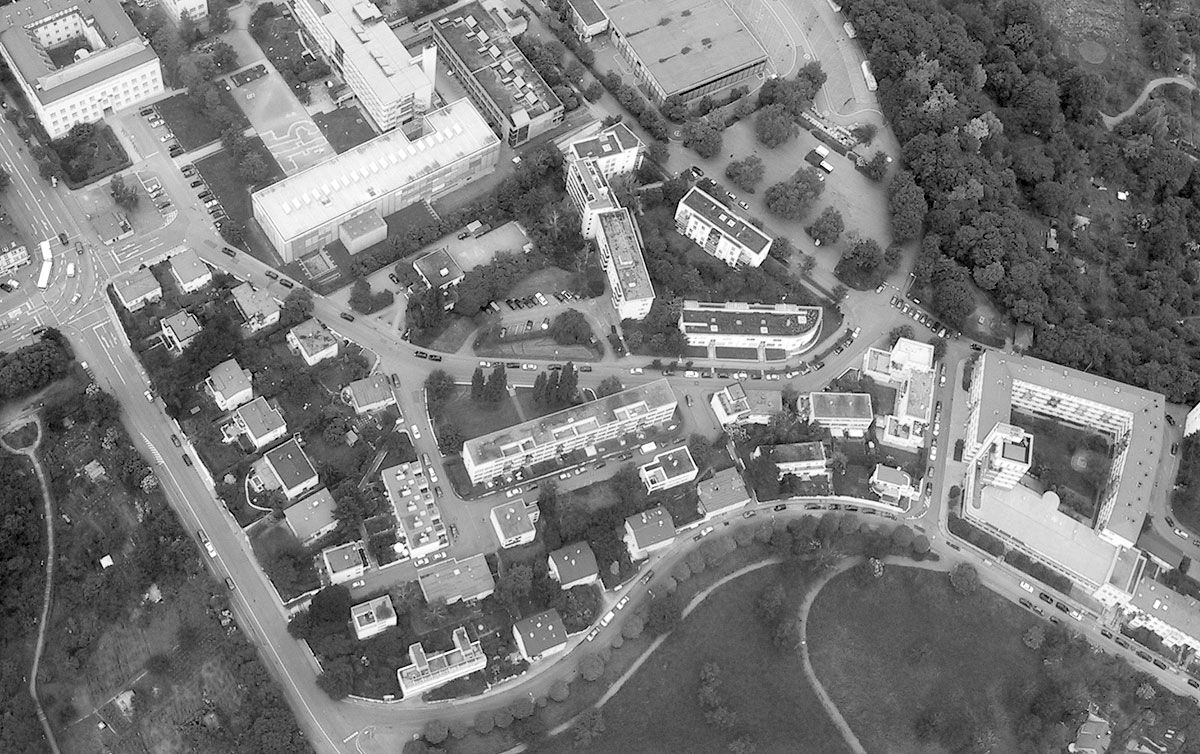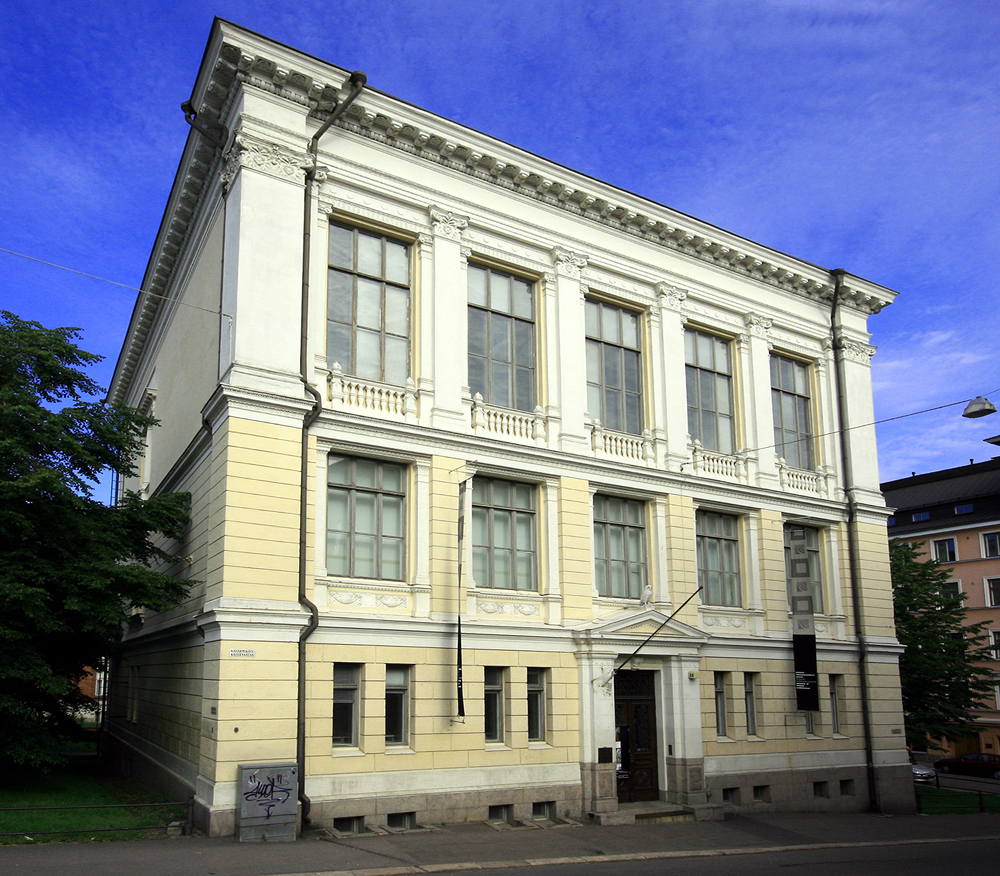|
Aulis Blomstedt
Yrjö Aulis Uramo Blomstedt (28 February 1906 – 21 December 1979) was a Finnish architect and professor of architecture at the Helsinki University of Technology. He was a renowned modernist architect and architectural theoretician in the decades following the Second World War. Blomstedt was born into an architect family: his father Yrjö Blomstedt was an architect known for his National Romantic Jugend architecture, while his older brother Pauli E. Blomstedt was, until his premature death at the age of 35, a pioneering early modernist architect. His other brother, Jussi Jalas (formerly Armas Jussi Veikko Blomstedt), was a composer. Blomstedt was married to Heidi Blomstedt, the daughter of the composer Jean Sibelius. They had two children, the artist Juhana Blomstedt and the architect Severi Blomstedt. Life and career Blomstedt spent his childhood in the city of Jyväskylä, and attended the same school as the renowned architect Alvar Aalto. From 1924 to 1930 Blomstedt studie ... [...More Info...] [...Related Items...] OR: [Wikipedia] [Google] [Baidu] [Amazon] |
Congrès Internationaux D'Architecture Moderne
The ''Congrès Internationaux d'Architecture Moderne'' (CIAM), or International Congresses of Modern Architecture, was an organization founded in 1928 and disbanded in 1959, responsible for a series of events and congresses arranged across Europe by the most prominent architects of the time, with the objective of spreading the principles of the Modern Movement focusing in all the main domains of architecture (such as landscape, urbanism, industrial design, and many others). Formation and membership The ''International Congresses of Modern Architecture'' (CIAM) was founded in June 1928, at the Chateau de la Sarraz in Switzerland, by a group of 28 European architects organized by Le Corbusier, Hélène de Mandrot (owner of the castle), and Sigfried Giedion, (the first secretary-general). CIAM was one of many 20th-century manifestos meant to advance the cause of ''architecture as a social art''. Members Other founder members included Karl Moser (first president), Hendrik Be ... [...More Info...] [...Related Items...] OR: [Wikipedia] [Google] [Baidu] [Amazon] |
People From Jyväskylä
The term "the people" refers to the public or Common people, common mass of people of a polity. As such it is a concept of human rights law, international law as well as constitutional law, particularly used for claims of popular sovereignty. In contrast, a people is any plurality of Person, persons considered as a whole. Used in politics and law, the term "a people" refers to the collective or community of an ethnic group or nation. Concepts Legal Chapter One, Article One of the Charter of the United Nations states that "peoples" have the right to self-determination. Though the mere status as peoples and the right to self-determination, as for example in the case of Declaration on the Rights of Indigenous Peoples, Indigenous peoples (''peoples'', as in all groups of indigenous people, not merely all indigenous persons as in ''indigenous people''), does not automatically provide for independence, independent sovereignty and therefore secession. Indeed, judge Ivor Jennings i ... [...More Info...] [...Related Items...] OR: [Wikipedia] [Google] [Baidu] [Amazon] |
1975 Deaths
It was also declared the ''International Women's Year'' by the United Nations and the European Architectural Heritage Year by the Council of Europe. Events January * January 1 – Watergate scandal (United States): John N. Mitchell, H. R. Haldeman and John Ehrlichman are found guilty of the Watergate cover-up. * January 2 ** The Federal Rules of Evidence are approved by the United States Congress. ** A bomb blast at Samastipur, Bihar, India, fatally wounds Lalit Narayan Mishra, Minister of Railways. * January 5 – Tasman Bridge disaster: The Tasman Bridge in Hobart, Tasmania, Australia, is struck by the bulk ore carrier , causing a partial collapse resulting in 12 deaths. * January 15 – Alvor Agreement: Portugal announces that it will grant independence to Angola on November 11. * January 20 ** In Hanoi, North Vietnam, the Politburo approves the final military offensive against South Vietnam. ** Work is abandoned on the 1974 Anglo-French Channel Tunnel scheme. * January ... [...More Info...] [...Related Items...] OR: [Wikipedia] [Google] [Baidu] [Amazon] |
1906 Births
Events January–February * January 12 – Persian Constitutional Revolution: A nationalistic coalition of merchants, religious leaders and intellectuals in Persia forces the shah Mozaffar ad-Din Shah Qajar to grant a constitution, and establish a national assembly, the National Consultative Assembly, Majlis. * January 16–April 7 – The Algeciras Conference convenes, to resolve the First Moroccan Crisis between French Third Republic, France and German Empire, Germany. * January 22 – The strikes a reef off Vancouver Island, Canada, killing over 100 (officially 136) in the ensuing disaster. * January 31 – The 1906 Ecuador–Colombia earthquake, Ecuador–Colombia earthquake (8.8 on the Moment magnitude scale), and associated tsunami, cause at least 500 deaths. * February 7 – is launched, sparking a Anglo-German naval arms race, naval race between Britain and Germany. * February 11 ** Pope Pius X publishes the encyclical ''Vehementer Nos'', de ... [...More Info...] [...Related Items...] OR: [Wikipedia] [Google] [Baidu] [Amazon] |
Tapiola
Tapiola (; ) is a district of the municipality of Espoo on the south coast of Finland, and is one of the major urban centres of Espoo. It is located in the western part of Helsinki capital region. The name ''Tapiola'' is derived from ''Tapio (spirit), Tapio'', who is the forest god of Finnish mythology, especially as expressed in the ''the Kalevala, Kalevala''. Tapiola was largely constructed in the 1950s and 1960s by the Finnish housing foundation and was designed as a Garden city movement, garden city. It is the location of the Espoo cultural centre, the Espoo Museum of Modern Art (EMMA), the Espoo city museum, and the Espoo City Theatre. According to the Finnish National Board of Antiquities, Tapiola was the largest and most valuable example of the 1960s construction ideologies in Finland. Its architecture and landscaping that combine urban living with nature have attracted tourists ever since. Name The original name for the Tapiola area was ''Björnvik'', based on a bay with ... [...More Info...] [...Related Items...] OR: [Wikipedia] [Google] [Baidu] [Amazon] |
Taucher & Blomstedt - Finnish Language Adult Education Centre, Helsinki
Taucher (German: diver) may refer to: * "Der Taucher", a ballad by Friedrich Schiller written in 1797 * DJ Taucher Ralph-Armand Beck (born 20 February 1966), known professionally as Taucher (German for "diver"), is a German trance DJ. Taucher began spinning in 1992, initially collaborating with Torsten Stenzel (1993–2003). He quickly became one of the bes ..., German trance DJ People with the surname * Gunnar Taucher (1886–1941), Finnish architect {{disambiguation, surname ... [...More Info...] [...Related Items...] OR: [Wikipedia] [Google] [Baidu] [Amazon] |
The Carré Bleu
''Le Carré Bleu'', originally known as ''feuille internationale d'architecture'' ("International Folio of Architecture"), is an architecture publication founded in Helsinki, Finland, in 1958, published quarterly in three languages (English, French, Italian) and distributed internationally. History and profile Following the final CIAM (International Congresses of Modern Architecture) congress, CIAM X, held in Dubrovnik in 1956, a CIAM Helsinki group met leading to the establishment of the magazine in 1958 to the birth of the journal of architecture theory ''Le Carré Bleu''. The founding group consisted of the Finnish architects Aulis Blomstedt, Keijo Petäjä and Reima Pietilä, Finnish architecture historian Kyösti Ålander, and French architect André Schimmerling, who was then living in Finland. The first editions were published solely in French with rare English additions. The original headquarters of the magazine was in Helsinki. The production moved to Paris in 1963 and ... [...More Info...] [...Related Items...] OR: [Wikipedia] [Google] [Baidu] [Amazon] |
Helsinki University Of Technology
Helsinki University of Technology (TKK; ; , HUT in international usage) was a technical university in Finland. It was located in Otaniemi, Espoo in the Helsinki metropolitan area, and it was one of the three universities from which the modern day Aalto University was founded. The university was founded in 1849 by Grand Duke of Finland, Emperor Nicholas I and received university status in 1908. It moved from Helsinki to Otaniemi campus area in 1966. The merger of HUT with two other schools created the Aalto University in 2010, and HUT briefly held the name Aalto University School of Science and Technology before being split into four schools in 2011. Much of the university's Otaniemi campus was designed by Alvar Aalto. History In 1849, TKK was established in Helsinki by the decree of the Russian Emperor Nicholas I, Grand Duke of Finland as a "manufacture and handicraft school", with the name ''Helsingin teknillinen reaalikoulu/Helsingfors tekniska realskola'', along w ... [...More Info...] [...Related Items...] OR: [Wikipedia] [Google] [Baidu] [Amazon] |
Museum Of Finnish Architecture
The Museum of Finnish Architecture (, ) is an architectural museum in Helsinki, Finland. Established in 1956, it is the second oldest museum of its kind (after the Shchusev Museum of Architecture in Moscow) devoted specifically to architecture. The museum was founded on the basis of the photographic collection of the Finnish Association of Architects (SAFA), which was established in 1949. The museum is on Kasarmikatu street in Ullanlinna, housed in a neo-classicism, neo-classical building, designed by architect Magnus Schjerfbeck and completed in 1899. The building was originally in the use of a scientific society and the University of Helsinki. The museum took over use of the building in 1981, before which it had been housed in a former wooden pavilion in Kaivopuisto Park. Occupying the same city block as the Museum of architecture is the Design Museum, Helsinki, Design Museum. In 1984 an Architectural design competition, architectural competition was arranged for a new building ... [...More Info...] [...Related Items...] OR: [Wikipedia] [Google] [Baidu] [Amazon] |
Alvar Aalto
Hugo Alvar Henrik Aalto (; 3 February 1898 – 11 May 1976) was a Finnish architect and designer. His work includes architecture, furniture, textiles and glassware, as well as sculptures and paintings. He never regarded himself as an artist, seeing painting and sculpture as "branches of the tree whose trunk is architecture." Aalto's early career ran in parallel with the rapid economic growth and industrialization of Finland during the first half of the 20th century. Many of his clients were industrialists, among them the Ahlström-Gullichsen family, who became his patrons. The span of his career, from the 1920s to the 1970s, is reflected in the styles of his work, ranging from Nordic Classicism of the early work, to a rational International Style (architecture), International Style Modernism during the 1930s to a more organic modernist style from the 1940s onwards. His architectural work, throughout his entire career, is characterized by a concern for design as Gesamtkunstwerk— ... [...More Info...] [...Related Items...] OR: [Wikipedia] [Google] [Baidu] [Amazon] |






